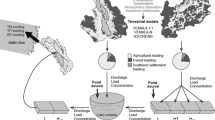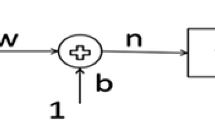Abstract
The objective of this study was to calibrate the Everglades Wetland Hydrodynamic Model (EWHM) to the Everglades Nutrient Removal (ENR) Project, from April 1995 through July of 1996. Model predictions were evaluated graphically and statistically against field observations to quantify the accuracy of model predictions and evaluate the success of model calibration. Comparisons between model predictions and field observations of water surface elevations at interior stations indicated that the model was successfully calibrated and model predictions were highly correlated with observed water surface elevations (r2 ranged from 0.79 to 0.84). Model-predicted chloride (Cl) concentrations fell within the observed range of field observations, further confirming the success of model calibration. Good agreement found in these comparisons between observed and predicted results warrants the use of the model in a predictive mode. This is further supported by noting that the model contains no adjustable constants and requires no computational fitting of parameters to experimental data as is necessary in many previous obstructed flow studies.
Similar content being viewed by others
References
W. Abtew, “Evapotranspiration measurements and modeling for three wetland systems in South Florida,” Journal of the American Water Resources Association 32, 465 (1996).
S. M. Anderson and A. C. Charters, “A fluid dynamics study of seawater flow through Galadium nudifrons,” Limnology and Oceanography 27, 399 (1982).
R. W. Burk and K. D. Stolzenbach, “Free surface flow through salt marsh grass,” Report MITSG 83-16, MIT Sea Grant Program, 252 pp. (1983).
Burns and McDonnell, Everglades Nutrient Removal Project Model Analysis(Burns and McDonnell, Kansas City, MO, 1992).
C. F. Cerco and T. M. Cole, in Estuarine and Coastal Modeling: Calibration of the Chesapeake Bay Water Quality Model, edited by M. L. Spaulding (American Society of Civil Engineers, New York, 1993), p. 190.
V. T. Chow, D.R. Maidment, and L. W. Mays, Applied Hydrology(McGraw-Hill, New York, 1988).
S. M. Davis, in The Ecosystem and its Restoration: Phosphorus Inputs and Vegetation Sensitivity in the Everglades, edited by S. M. Davis and J. C. Ogden (St. Lucie Press, Delray Beach, 1994), p. 357.
J. de Jong, in Biological Control of Water Pollution: The Purification of Wastewater with the Aid of Rush or Reed Ponds, edited by J. Tourbier and R. W. Pierson (University of Pennsylvania Press, Philadelphia, 1976), p. 133.
P. J. Dillon, “The phosphorus budget of Cameron Lake, Ontario: The importance of flushing rate to the degree of eutrophy of lakes,” Limnology and Oceanography 20, 28 (1975).
H. B. Fischer, E.J. List, R.C.Y. Koh, J. Imberger, and N.H. Brooks, Mixing in Inland and Coastal Waters(Academic Press, New York, 1979).
B. Galperin, L. H. Kantha, S. Hassid, and A. Rosati, “A quasi-equilibrium turbulent energy model for geophysical flows.” Journal of Atmospheric Science 45, 55 (1988).
V. Gerard and K. H. Mann, “Growth and production of Laminaria longicurispopulations exposed to different intensities of water movement,” Journal of Phycol. 15, 33 (1979).
M. Guardo, L. Fink, T.D. Fontaine, S. Newman, M. Chimney, R. Bearzotti, and G. Goforth, “Large-scale constructed wetlands for nutrient removal from stormwater runoff: An Everglades restoration project,” Environmental Management 19, 879 (1995).
D. E. Hammer and R.H. Kadlec, “A model for wetland surface water dynamics,” Water Resource. Res. 13, 1951 (1986).
J. M. Hamrick, “A three-dimensional Environmental Fluid Dynamics Computer Code: Theoretical and Computational Aspects,” The College of William and Mary, Virginia Institute of Marine Science, Special Report 317 (1992).
J. M. Hamrick, in Estuarine and Coastal Modeling: Linking hydrodynamic and biogeochemcial transport models for estaurine and coastal waters, edited by M. L. Spaulding et al. (American Society of Civil Engineers, New York, 1994), p. 591.
J. M. Hamrick, “A User's Manual for the Environmental Fluid Dynamics Computer Code (EFDC),” The College of William and Mary, Virginia Institute of Marine Science, Special Report 331 (1996).
J. M. Hamrick and M. Z. Moustafa, “Development of the Everglades Wetland Hydrodynamic Model, Part I: Model Formulation,” Water Resources Research (In Review) (1999a).
J. M. Hamrick and M. Z. Moustafa, “Development of the Everglades Wetland Hydrodynamic Model, Part II: Model Implementation,” Water Resources Research (In Review) (1999b).
J. M. Higgins and B. R. Kim, “Phosphorus retention models for Tennessee Valley Authority Reservoirs,” Water Resources Research 17, 571 (1981).
C. Howard-Williams, “Cycling and nutrient retention of nitrogen and phosphorus in wetlands: a theoretical and applied perspective,” Freshwater Biology 15, 391 (1985).
A. Jones and G. F. Lee, “An approach for the evaluation of efficiency of wetlands-based phosphorus control programs for eutrophication related water quality improvement in downstream water bodies,” Water, Air, and Soil Pollution 14, 359 (1980).
R. H. Kadlec, “Overland flow in wetlands: Vegetation resistance,” Journal of Hydraulic Engineering 116, 691 (1990).
R. H. Kadlec, Treatment Wetlands(CRC Press, Inc., New York, 1996).
A. B. Lawrence and R. B. Taylor, “Nutrient-uptake in marsh ecosystems,” Journal of the Technical Councils of the American Society of Civil Engineers 105, 177 (1979).
J. J. Leendertse and E.C. Gritton, “A water quality simulation model of well-mixed estuaries and coastal seas: Vol. 2, computational procedures,” Rand Corp. Report R-708-NYC, NY (1971).
R. H. S. McColl, “Chemical runoff from pasture: the influence of fertilizer and riparian zones,” New Zealan Journal of Marine and Freshwater Research 12, 371 (1979).
P. V. McCormick and M.B. O'Dell, “Quantifying Periphyton Responses to Phosphorus in the Florida Everglades: a Synoptic Experimental Approach,” Journal of North American Benthological Society 15, 450 (1996).
G. L. Mellor and T. Yamada, “Development of a turbulence closure model for geophysical fluid problems,” Rev. Geophys. Space Phys. 20, 851 (1982).
WJ. Mitsch, “Landscape design and the role of created, restored, and natural riparian wetlands in controlling nonpoint source pollution,” Ecological Engineering 1, 27 (1992).
M. Z. Moustafa and J. M. Hamrick, in Estuarine and Coastal Modeling: Modeling circulation and salinity transport in the Indian River Lagoon, edited by M. L. Spaulding et al. (American Society of Civil Engineers, New York, 1994), p. 381.
M. Z. Moustafa, M. J. Chimney, T. D. Fontaine, and G. Shih, “The response of a freshwater wetland to long-term “low level” nutrient loads: Marsh Efficiency,” Ecological Engineering 7, 15 (1996).
M. Z. Moustafa, “Graphical representation of nutrient removal in constructed wetlands,” Wetlands 17, 493 (1997).
M. Z. Moustafa, “Long-term equilibrium phosphorus concentrations in the Everglades as predicted by a Vollenweider-type model,” Journal of the American Water Resources Association 34, 135 (1998).
M. Z. Moustafa, “Nutrient retention dynamics by the Everglades Nutrient Removal Project,” Wetlands 19, 689 (1999).
M. Z. Moustafa, S. Newman, T. D. Fontaine, M. J. Chimney, and T. Kosier, Phosphorus retention by the Everglades Nutrient Removal Project: an Everglades Stormwater Treatment Area, in Phosphorus Biogeochemistry in Sub-tropical Ecosystems, edited by K. R. Reddy, G. A. O'Conner, and C. L. Schelske (Lewis Publishers, Boca Raton, 1999).
P. J. Mulholland, L. A. Yarbro, R. P. Sniffen, and E. J. Kuenzler, “Effects of floods on nutrient and metal concentrations in a coastal plain stream,” Water Resources Research 17, 758 (1981).
S. Newman, J. Grace, and J. W. Kobel, “Effects of nutrient and hydroperiod on Typha. Cladium, and Eleocharis: Implications for Everglades restoration,” Ecological Applications 6, 774 (1996).
S. Newman, J. Schuette, J. B. Grace, K. Rutchey, T.D. Fontaine, K.R. Reddy, and M. Pietrucha, “Factors influencing cattail abundance in the northern Everglades,” Aquatic Botany 60, 265 (1998).
J. H. Peverly, “Stream transport of nutrients through a wetland,” Journal of Environmental Quality 11, 38 (1982).
A. A. Prymas, “Calibration of seepage from steady state simulation for water budget estimation,” Mater thesis, Florida Atlantic University, Boca Raton, Fl. (1997).
R. O. Reid and R.E. Whitaker, “Wind-driven flow of water influenced by a canopy,” Journal Waterways, Harbors, Coastal Engr. Div. 102, 61 (1976).
K. Rutchy and L. Vilchek, “Development of an Everglades vegetation map using a SPOT image and the Global Positioning System,” Photogrammetric Engineering and Remote Sensing 6, 767 (1994).
SAS Institute Inc., SAS/GRAPH Software: Reference, Version 5, First Edition, Vol.1. (SAS Institute Inc., Cary, North Carolina, 1990).
South Florida Water Management District, Everglades Nutrient Removal Project, 1995 Monitoring Report. South Florida Water Management District, West Palm Beach, FL. (1996).
South Florida Water Management District, Everglades Nutrient Removal Project, 1996 Monitoring Report. South Florida Water Management District, West Palm Beach, FL. (1997).
F. W. Spangler, W. Sloey, and C. W. Fetter, Experimental use of emergent vegetation for the biological treatment of municipal wastewater in Wisconsin, in Biological Control of Water Pollution, edited by J. Tourbier and R. W. Pierson (University of Pennsylvania Press, Philadelphia, 1976), p. 161.
K. K. Steward and W. H. Ornes, “The autecology of sawgrass in the Florida Everglades,” Ecology 56, 162 (1975).
J. R. Stedinger, R.M. Vogel, and E. Foufoula-Georgiou, Frequency Analysis of Extreme Events in Handbook of Hydrology, edited by D.R. Maidment (McGraw-Hill, New York, 1993).
V. T. Thomann and J. A. Mueller, Principles of Surface Water Quality Modeling and Control(Harper and Row, Publishers, New York, 1987).
R. Tomasello, User's Guide for SHEET2D(Tomasello Consulting Engineers, Inc. Jupiter, FL., 1992).
B. G. Volk, “Everglades Histosol Subsidence: 1. CO2Evolution as Affected by Soil Type, Temperature and Moisture,” Soil and Crop Science Society of Florida 32, 132 (1972).
R. A. Vollenweider, “Input-output models, with special reference to the phosphorus loading concept,” Limnology. Schweiz. Zeit. Hydrol. 37, 53 (1975).
R. Walton, R. S. Chapman, and J. E. Davis, “Development and application of the wetlands dynamic water budget model,” Wetlands 16, 347 (1996).
N. R. Wilson, and R. H. Shaw, “A higher order closure model for canopy flow,” Journal of Applied Meteorol. 16, 1197 (1977).
D. H. Zhao, G.Q. Tabios, and H. W. Shen, RBFVM-2D, River basin two-dimensional model using finite volume method: Program documentation(University of California, Berkeley, 1992).
Author information
Authors and Affiliations
Rights and permissions
About this article
Cite this article
Moustafa, M.Z., Hamrick, J.M. Calibration of the Wetland Hydrodynamic Model to the Everglades Nutrient Removal Project. Water Quality and Ecosystem Modeling 1, 141–167 (2000). https://doi.org/10.1023/A:1013938700446
Issue Date:
DOI: https://doi.org/10.1023/A:1013938700446




